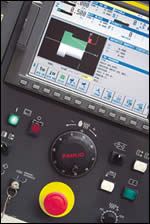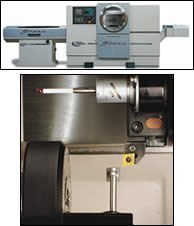Reducing The Anxiety When Turning Lights-Out
A turnkey lights-out package for CNC lathes may allay the concerns that shop owners may have in letting their machines run unsupervised during the night.
Share




There are clear benefits to letting a bar-fed lathe run unattended overnight or through the weekend. Increased production capacity, greater spindle uptime, optimized setup times and quicker deliveries are a few. Yet some shops have qualms about letting their machines run unsupervised throughout the night; imagine walking in the following work day morning to find that a worn tool generated oodles of bad parts, a tool broke or, worst-case scenario, the machine crashed.
Colchester Lathes has developed a turnkey lights-out package for its Storm T two- and three-axis lathes to allay these concerns. Colchester Lathes equipment is available in the United States through Clausing Industrial Inc. (Kalamazoo, Michigan). The key components of this package are programmable bar feeder, tool life monitoring system, chip conveyor, parts catcher, and part and tool probes. These elements are administered by on-board scheduling software that allows multiple jobs to be machined from the same bar size. That way, a lathe can keep busy throughout the night processing a variety of small-batch-size jobs, instead of being relegated to a single high-volume job that a shop may or may not have.
According to Dr. Stephen Le Beau, product strategy and marketing director for Colchester Lathes, the lights-out package was developed to provide shops hoping to run their lathes unattended with a safety net to catch tool wear and breakage problems before they rear their ugly heads. The workaround that shops often use to circumvent these problems is scheduling regular tool changes based on estimated tool life. Overly wary shops will lowball this tool life estimation, erring on the side of caution. By scheduling tool change based on such guesstimation, rather than actual tool condition, a good portion of a tool’s available cutting time can be wasted.
The lights-out package automatically monitors tool life by either tracking spindle motor current levels or probing tools. Because the spindle motor will experience a greater current draw when a worn tool is cutting versus a good tool, the lights-out package will automatically change a tool if the current draw exceeds a preset limit. In the case of a broken tool, the spindle motor would experience no current draw resulting from cutting load, and a tool change would be initiated. Alternately, by probing the tool at preset intervals, it can be determined if the tool has changed in size or has broken. In addition to tool measurement, probing capability also allows for in-process gaging of key part features.
Dr. Le Beau suggests that shops implementing unattended operation for the first time start with jobs that have fairly simple geometries, key dimensions that can be easily probed and a limited number of tools required. As shops get familiar with unattended machining practices, they likely will gain the confidence to run more of their complex work overnight.
Related Content
-
Inside the Premium Machine Shop Making Fasteners
AMPG can’t help but take risks — its management doesn’t know how to run machines. But these risks have enabled it to become a runaway success in its market.
-
4 Steps to a Cobot Culture: How Thyssenkrupp Bilstein Has Answered Staffing Shortages With Economical Automation
Safe, economical automation using collaborative robots can transform a manufacturing facility and overcome staffing shortfalls, but it takes additional investment and a systemized approach to automation in order to realize this change.
-
Investing in Automation, Five-Axis to Increase Production Capacity
To meet an increase in demand, this shop invested heavily in automation solutions and five-axis machines to ramp up its production capabilities.























.png;maxWidth=300;quality=90)



